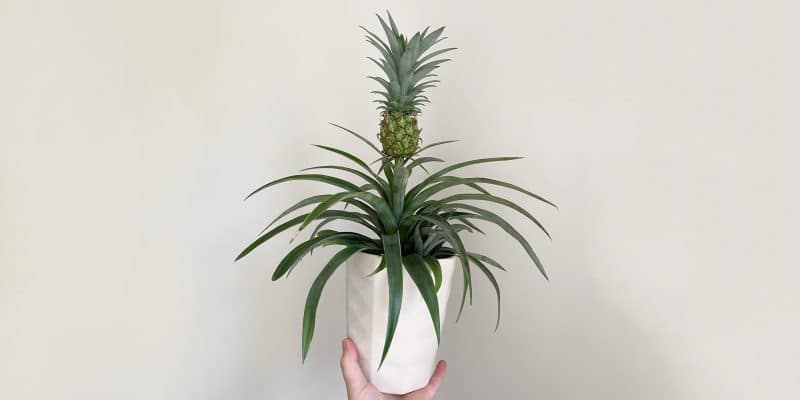The Pineapple Plant not only looks fabulous but also produces sweet, tangy edible fruit. With its spiky, green leaves and distinctive pineapple fruit crowning its top, this exotic beauty is sure to be a conversation starter at your next get-together.
The Pineapple Plant is surprisingly low maintenance and resilient. Plus, your new pineapple pal is not just a source of tropical fruit, but it has a rich history and unique horticultural quirks that make it truly one of a kind.
We’ll reveal everything you need to know about Pineapple Plant care, from its origins and ideal environment to troubleshooting common issues. Let’s get tropical!
Table of Contents
Pineapple Plant Care Guide
History, Habitat, and Characteristics
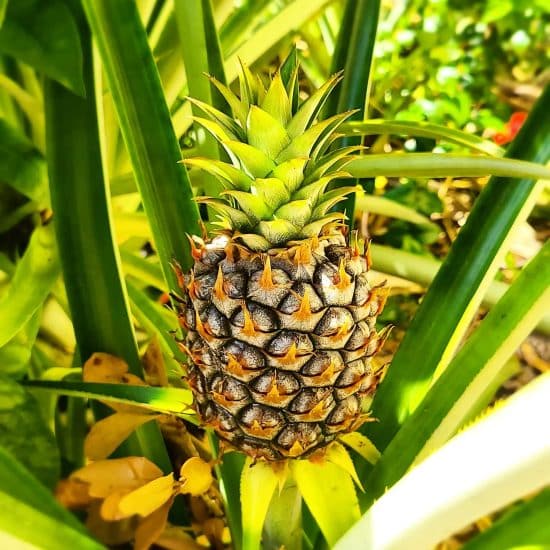
Hailing from the tropical region between Costa Rica and Paraguay, the Pineapple Plant (Ananas comosus) has made quite a journey through South America. Believe it or not, the Pineapple Plant has mingled with the Aztecs in Mexico, European explorers, and partygoers since the 18th century.
These social butterflies belong to the Bromeliaceae family, just like their stylish cousins, tillandsias and bromeliads. They all share a similar fashion sense, sporting a fabulous showy flower once in their lives, before gracefully bowing out and leaving new baby plants behind to carry on the family name.
Now, if you’ve got a pineapple top and tropical dreams, you’re in luck! With just one crown, you can grow a pineapple with multiple baby plants in your very own home.
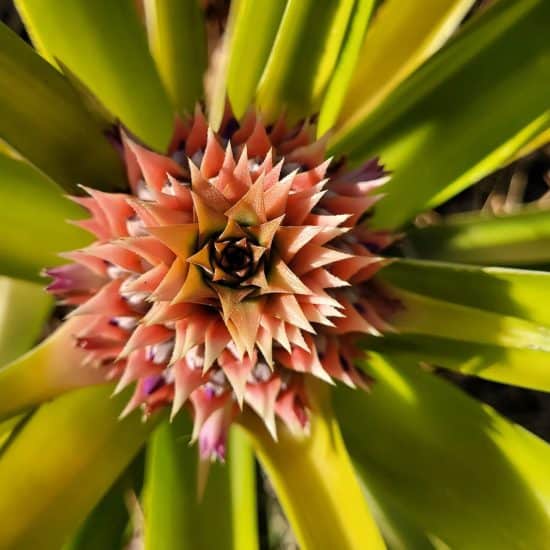
The Pineapple Plant loves warm, humid environments and has a neat trick to stay hydrated — it absorbs water and nutrients through its green leaves instead of relying solely on roots.
Fun fact: Pineapples used to be the life of the party! They symbolized hospitality and friendship in the 18th century and were often rented out for gatherings to show the host’s generosity — how sweet is that?
Light
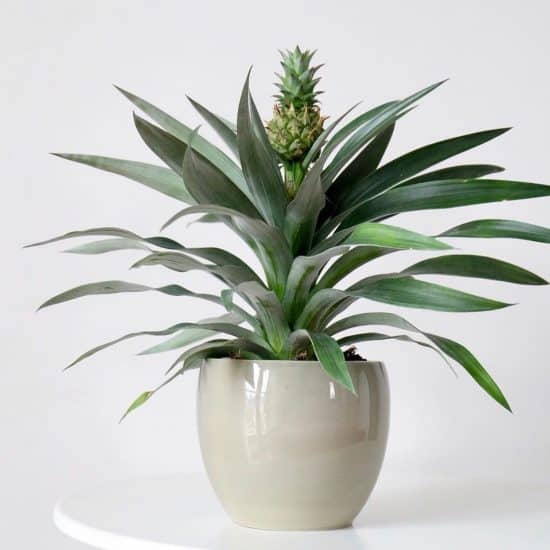
Your Pineapple Plant will appreciate bright light, and it can even handle a few hours of direct sunlight daily — at least 6 hours per day, to be exact. You can grow a Pineapple Plant indoors on a sunny windowsill or outdoors in a sunny area.
When your Pineapple Plant isn’t getting enough light, expect slow growth and weak, stretched-out stems. The leaves might lose their vibrant green color and appear dull as well.
On the other hand, too much direct sunlight, though rare for these sun-loving plants, can cause yellow leaves and even small holes, similar to sunburn.
Our lighting tips:
- Find a bright, sunny spot with bright light, preferably close to a south- or west-facing window.
- A few hours of direct sunlight daily is great, but keep an eye out for signs of sunburn.
- Rotate your plant occasionally, ensuring even growth and balanced exposure to light.
- If natural light is scarce in your space, think about using a full-spectrum LED grow light as a supplement.
Water
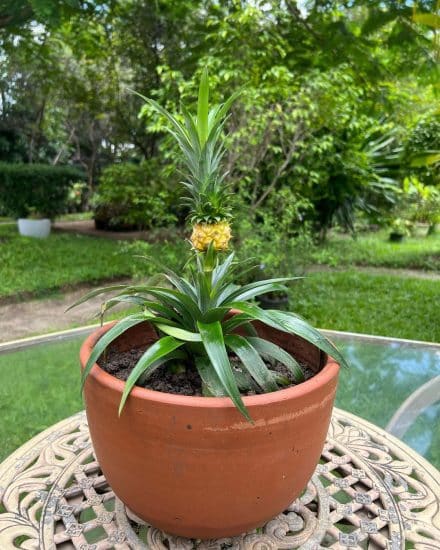
When growing a Pineapple Plant outdoors, it needs daily watering due to intense sunlight. But for an indoor plant, you’ll need to adjust your watering technique.
To avoid overwatering, allow the potting soil to almost dry out completely between waterings. Pour water on the side of the pot instead of the center or from the top.
You might be tempted to water bromeliads from the top, but indoors, that can lead to rot because of limited evaporation and air circulation.
Make sure you water your pineapple plant thoroughly, but be cautious about overwatering. Excess water can cause the sections to rot, so ensure it drains away through the holes at the bottom of the container. And again, let the soil dry out between waterings.
Not enough water: If your Pineapple Plantcould use more water, you’ll notice the oldest leaves turning yellow and curling. To fix this, increase the frequency of watering and remove any dying leaves to keep pesky pests at bay.
Too much water: Overwatering can show up as yellowing leaves throughout the plant, mushy stems, and stubbornly moist soil. Watch out for brown leaf tips and small brown and black spots on the leaves, which may signal root rot. In that case, cut back on the watering frequency and let the soil dry out.
Our watering tips:
- Water your indoor Pineapple Plant from the side of the pot (not from the top).
- Let the potting soil almost dry out completely between waterings.
- Make sure excess water drains through holes at the bottom of the container.
- Keep an eye on your plant for signs of overwatering and underwatering, adjusting your watering routine as needed.
Temperature and Humidity
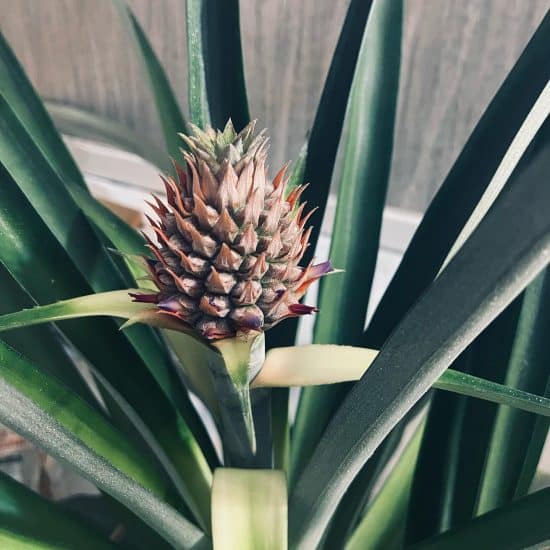
Temperature is crucial for growing a Pineapple Plant successfully. They enjoy warmth but not extreme heat. Aim for room temperatures between 65-85°F (18-29°C) during the day, and it’s perfectly fine to see a 10-degree drop in temperature at nighttime. Just avoid exposing them to cold drafts or drastic temperature changes, which can damage plants.
If you notice your pineapple plant has yellow leaves or is growing very slowly, the temperature could be too low. On the other hand, if the leaves are turning brown and crispy, the temperature might be too high.
So make sure to place your plant in an area where the temperature is stable. Avoid keeping it near heating and air conditioning vents.
Now that you’ve sorted out the Pineapple Plant’s temperature needs, let’s talk about humidity. As a tropical plant, the Pineapple Plant enjoys a humid environment, so aim for humidity levels between 40% and 60%.
Drooping leaves or brown leaf tips could indicate the humidity level is too low, while mold growth or fungus might indicate too much moisture.
To maintain proper humidity for your pineapple plant, consider using a humidifier or placing it near other plants for increased moisture. You can also set your plant on a tray filled with pebbles and water to boost humidity levels. Just be careful not to overdo it and cause excessive moisture.
Soil and Planting
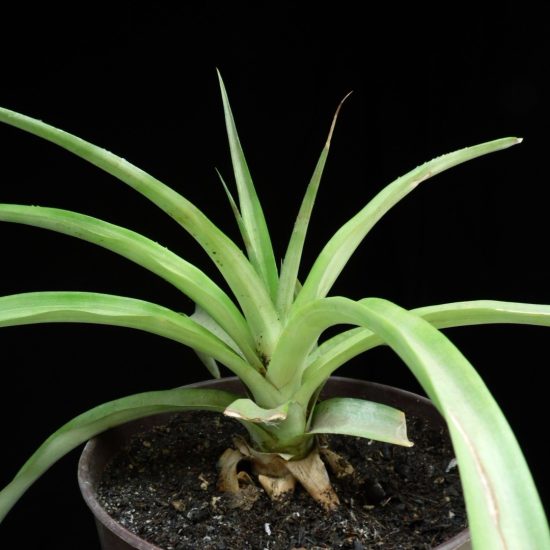
Pineapple Plants are adaptive and can grow well in a variety of potting media, but selecting the ideal composition is key to a healthy and thriving plant. These guys need loamy, sandy soil to thrive.
You can use one part citrus and one part cactus mix, or opt for an orchid mix with equal parts coco coir, perlite, and coarse sand.
Signs of poor conditions and issues with the wrong mix can manifest in your Pineapple Plant as yellow leaves, stunted growth, or an overall weak appearance. If you notice any of these symptoms, consider amending the existing mix with additional organic material, such as compost, and well-draining components like perlite or pumice.
Because pineapples are bromeliads, you won’t need to repot them often, especially a potted Pineapple Plant, which grows slower and stays smaller. If necessary, though, do so during the active growing season to avoid causing undue stress to the plant.
Select a pot just one or two sizes larger than the current container, ensuring it has adequate drainage holes.
You’ll also need to repot the new baby plants that sprout from the parent plant after it flowers and produces offshoots. Simply separate them using a sharp knife, being sure to include roots with each specimen.
Use the same soil mixture we described above, and make sure the pot is the appropriate size for the small plant.
Fertilizing
Start off by fertilizing your pineapple plant with a high-nitrogen fertilizer to promote initial growth, and then switch to a phosphorus-rich fertilizer as the plant matures to encourage blooming and fruiting.
Over-fertilizing can be harmful to your Pineapple Plant. Signs of too much fertilizer may include leaf burn, brown leaf tips, excessive leaf drop, and leggy growth.
Over-fertilization can also prevent flowering, defeating the entire purpose of growing pineapples!
If you suspect over-fertilization, stop feeding immediately and flush the mix with water to help leach out excess nutrients. Resume fertilizing at a reduced rate and frequency, and always follow the recommended application rates on the fertilizer package.
Propagation
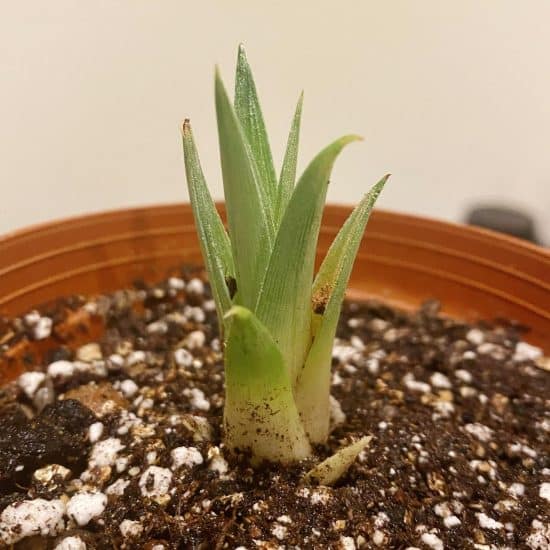
While pineapples propagate themselves with offshoots, you can also propagate from the fruit. Crown removal is a fantastic way to propagate your pineapple plant, grow your collection, and spread the plant love to your friends and family.
Propagate pineapple plant via crown removal:
- Pick a sweet pineapple. This fruit will give you the top, aka the crown, needed for propagation.
- Twist off the pineapple crown like you’re opening a bottle of soda. You can also use a knife, but be gentle so you don’t hurt the crown.
- Snip off any fruit attached to the crown. This step is super important because nobody wants rotting fruit interfering with their Pineapple Plant’s growth.
- Strip the lower leaves from the crown’s top, revealing the part where roots will show up. This will create more room for those roots to grow strong and healthy.
- Give the cut surface of the crown a little break for a day or two. This will help stop any bad bacteria or fungi from crashing the Pineapple Plant party.
- (Optional) Pop the cut top into a small container filled with water. This step can get the roots growing before you plant them in soil. Keep the pineapple in a bright spot with indirect light for 3-4 months, or until roots appear. Just remember to change the water occasionally.
- Plant the sections in containers with a perfect Pineapple Plant soil mix.
- Feed your Pineapple Plant an NPK fertilizer according to the product’s directions. This step will feed your plant all the yummy nutrients it needs to grow big and strong.
- After 3 months, move the baby plants into larger containers. And don’t forget drainage holes to keep rotting roots at bay!
- Keep your Pineapple Plant happy with water, fertilizer, and plenty of sun. Keep an eye on its progress and adjust your care routine as needed for tip-top growth.
Our tips:
- Use a sharp, clean knife or pruner when making cuts.
- Be patient during the propagation process. Pineapple Plants can be slow to show off their roots, but it’s worth the wait!
- Give your Pineapple Plant the royal treatment: A well-draining soil mix, the right sunlight, and proper watering and fertilizing will keep it thriving.
Common Issues
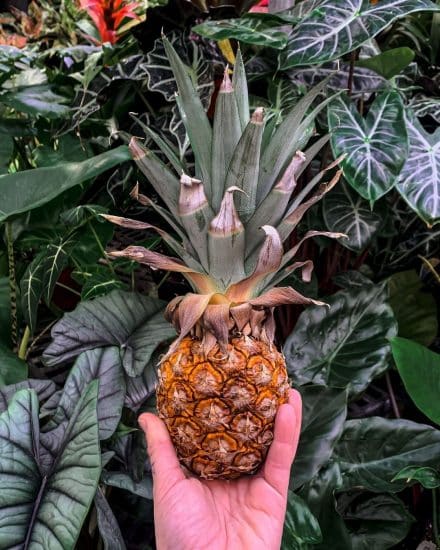
Common Pineapple Plantt problems, such as overwatering and brown leaves, have equally common causes and simple solutions, so let’s dive in.
Overwatering
When grown indoors, Pineapple Plants can sometimes fall victim to rot. This happens when there’s too much water and not enough evaporation or air circulation. If you notice yellowing leaves, a mushy stem, consistently wet soil, and a rotten smell, overwatering and root rot might be the culprits.
To mitigate this issue and save your plant, remove it from its pot and inspect the affected roots. Snip away any rotten roots with clean scissors and repot the plant in fresh soil. Be sure the pot has drainage holes to prevent similar problems in the future.
Moving forward, don’t be too generous with the water. Give the soil a chance to dry out between waterings, and don’t let standing water collect in a drip saucer.
Brown Leaves
More often than not, brown Pineapple Plant leaves are the result of insufficient watering or too much direct sunlight.
To figure out the cause, take a closer look at where the browning starts. If it begins at the leaf tips and works its way down, then your Pineapple Plantis probably thirsty or craving a bit more sunlight.
To fix this, be consistent with watering and find a cozy spot for your plant where it can bask in bright, indirect sunlight.
But if the browning is creeping up from the bottom of the leaves… you might have a case of overwatering or rotting roots on your hands (it’s a delicate balance!).
In this situation, it’s time for a little plant surgery. Snip away the affected roots, repot your Pineapple Plantin fresh, well-draining soil, and give it a break from watering for a few days.
Keep a watchful eye on your leafy friend, and adjust your watering schedule as needed to ensure it stays happy and healthy!
Pests
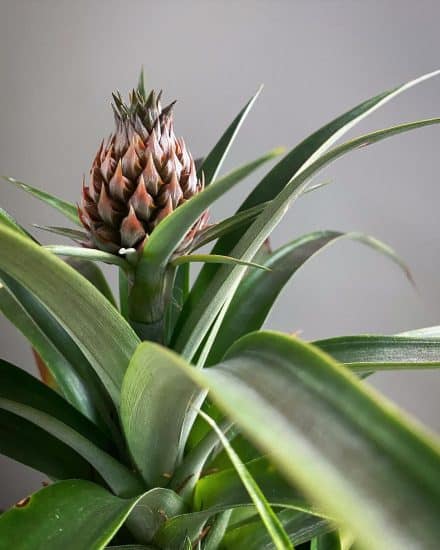
You know what they say: an ounce of Pineapple Plant prevention is worth a pound of cure, so we’ll cover how to spot and handle mealybugs and scale infestations.
Mealybugs
Mealybugs are pesky little cotton-like critters that just love to make a meal out of Pineapple Plants. They drain the sap out of your plant, causing leaves to turn yellow and wither away, and can even stunt our plant’s growth. Not cool, right?
Look for tiny white or gray cottony clusters hanging out on the leaves, stems, or hiding at the base of your Pineapple Plant.
To get rid of them, dab those little buggers with a cotton swab soaked in rubbing alcohol or gently pluck them off with tweezers. If your Pineapple Plant has really got the mealybug blues, try spraying it with a mix of water, dish soap, and a dash of neem oil. Just make sure you coat every leaf and stem — no survivors!
The key to mealybug-free living is constant vigilance. Overwatering can create a damp playground that invites mealybugs to come out and play.
Regularly inspect your Pineapple Plant for any signs of an invasion, and keep your plant happy with proper care and good airflow.
Scale
These tiny, flat, oval-shaped freeloaders latch onto Pineapple Plants and feast on their sap. The result? Yellowed leaves, stunted growth . . . and a sticky mess called honeydew that attracts even more pests, including ants!
Keep an eye out for small, flat, brown, or tan bugs. They hang out on leaves, stems, or near the base of your pineapple plant, posing as innocent little bumps.
Gently scrape them off with a soft toothbrush or similar item. For more-severe infestations, arm yourself with a spray bottle filled with water, dish soap, and a few drops of neem oil or horticultural oil. Blast those leaves and stems until every last scale insect is history.
Make scale insects think twice about returning by keeping your Pineapple Plant in tip-top shape with proper watering and fertilizing, as well as inspecting it regularly for any signs of a new infestation.
Don’t forget to give your Pineapple Plant some breathing room — good airflow does wonders for deterring pests.
Conclusion
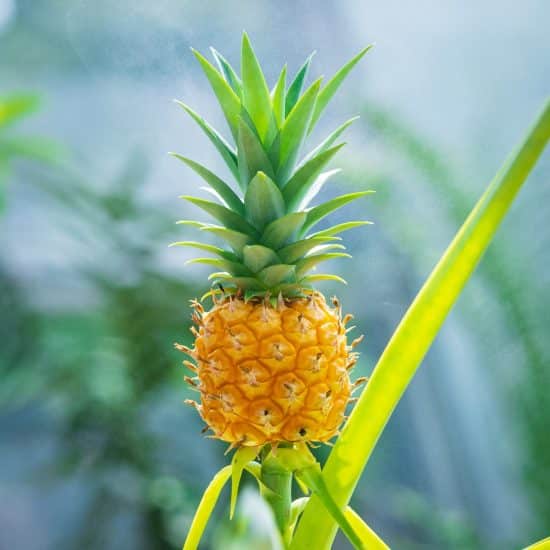
That’s a wrap on our Pineapple Plant care guide! Ready to start growing a Pineapple Plant and encouraging it to produce edible fruit? We believe in you!
Pineapple Plant care summary:
- Keep your Pineapple Plant in bright, indirect light, with a few hours of direct sunlight daily.
- Make sure to provide a warm, humid environment, and use a well-aerated soil.
- Allow the soil to almost dry out completely between waterings and water from the side of the pot to avoid soaking the crown.
- Fertilize your Pineapple Plant with a high-nitrogen fertilizer during initial growth and switch to a phosphorus-rich fertilizer as the plant matures.
- Propagate via crown removal — it’s easy and fun!
- Keep an eye out for common pests like mealybugs and scale insects.
We hope this guide has provided you with valuable tools to care for your Pineapple Plant and enjoy years of homegrown tropical fruit. If you have any questions or need further assistance, feel free to reach out to us.
And if you found this guide helpful, go ahead and share it with your fellow plant lovers!
Happy pineapple growing!
FAQ
Can you use normal store-bought pineapples?
Absolutely! You can use a normal store-bought pineapple to grow your very own pineapple plant. Just make sure to pick a fresh, healthy-looking fruit with a vibrant green crown. Once you’ve enjoyed the fruit, follow the steps to remove and prepare the crown to plant.
Can you keep a Pineapple Plant inside?
Yes, you can definitely keep a Pineapple Plant inside your home. In fact, growing Pineapple Plant indoors is quite popular, especially for those who don’t live in a tropical climate. All you need to do is recreate the plant’s natural habitat with the right lighting, temperature, and humidity.
Place your Pineapple Plant near a bright, sunny window with indirect light. Keep it at a comfortable temperature between 65-85°F (18-29°C), and maintain humidity levels between 40% and 60%. With a little TLC, your indoor Pineapple Plant will thrive and brighten up your space with its tropical charm.
Will Pineapple Plants produce fruit?
Yes, Pineapple Plants can grow fruit, but it may take some time and patience. Generally, it takes about 18-24 months for Pineapple Plant flowers to appear and grow fruit. Once the plant has matured and is ready to flower, you’ll notice a gorgeous, showy flower spike that eventually turns into a ripe fruit.
Keep in mind that an indoor Pineapple Plant might produce smaller fruit compared to its outdoor counterparts. Don’t worry, though — the fruit will still be deliciously sweet and a true testament to your loving care as a plant parent.
No matter how long it takes or how small it is, you can enjoy the satisfaction of fresh pineapple you’ve grown yourself!

